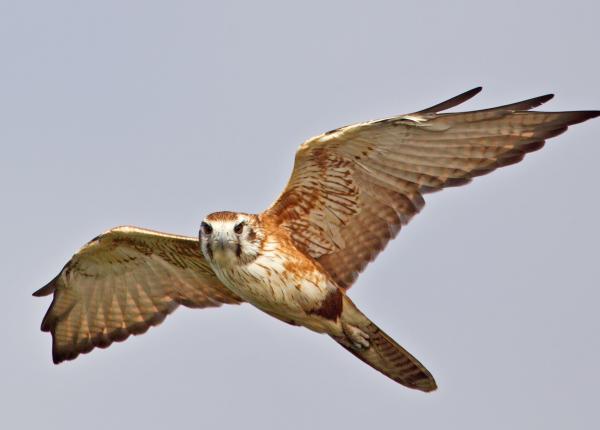How The Peregrine Fund is Helping
Though The Peregrine Fund doesn't work directly with Brown Falcons, our efforts in scientific research, habitat conservation, education, and community development help conserve raptors on a global scale. We also supply literature to researchers from our avian research library, which helps scientists around the world gather and share important information on raptor conservation. Our support of the Global Raptor Information Network gives raptor researchers tools to more efficiently conduct their own studies while contributing to a global program. It also provides citizen scientists a way to participate in raptor science and conservation.
Where They Live
Brown Falcons are found in parts of Australia and New Guinea. This lovely falcon prefers open habitats in which to live including grasslands, farm fields, scrub, desert, and savanna. However, it does avoid dense forests.
What They Do
If you ever find yourself in Brown Falcon habitat, be sure to scan the obvious perches, just in case. These birds can often be found perched on fenceposts, power poles or wires, and the tops of dead trees. Scientists have reported that this species sometimes congregates in groups of up to 50 individuals, particularly when locusts, other insects and mice occur in huge numbers.
Why They Need our Help
Though this falcon is considered a species of Least Concern, that doesn't mean it doesn't face some threats. In particular, it is sometimes shot or trapped by humans.
What They Eat
This falcon feeds on a wide variety of animals including rats, birds, reptiles, amphibians, fish, carrion, and large insects. To catch a variety of prey, it must hunt in a variety of ways. It sometimes perches on an exposed branch, swooping down to catch prey from the ground, or chases snakes and other small animals on foot or catches and eats insects on the wing. it hovers or soars low in search of prey and chases for prey through the tree canopies. It also takes nestling birds from nests, or by reaches into tree hollows. It is also known to pirate (steal) prey from other raptors. It follows grassfires, livestock, and farm machinery to capture flushed prey, and members of a pair sometimes hunt together. It is also known to feed on roadkill or other carrion, especially when prey is scarce.
Nests, Eggs, and Young
Like most falcons, the Brown Falcon doesn't build its own nest, but rather lays its eggs in the old stick nests built and abandoned by other raptors or corvids. It usually nests in trees, but also on artificial structures. The female will lay around 2 or 3 eggs, and the eggs need to be incubated for about 33 day. After the young hatch, they will remain in the nest for roughly 36-42 days before flying for the first time.
Once the young fly, they will remain with their parents for several more weeks (sometimes up to 6) learning how to hunt, avoid danger, and otherwise survive. After that, they will disperse from their parents' territory.
Brown Falcon and the World Center for Birds of Prey
The World Center for Birds of Prey offers fun ways to learn about birds of prey. The visitor center offers interactive displays, tours, interesting videos and a children's room with activities from coloring sheets to quizzes to costumes and a touch table - all available for the curious mind. We also have several different birds of prey on display year-around, including several falcon species such as Aplomado Falcon, American Kestrel, and Gyrfalcon. Knowledgeable staff and volunteers are on hand to answer any questions you may have about Brown Falcons or any other birds of prey.
References:
Debus, S., G. M. Kirwan, P. F. D. Boesman, and J. S. Marks (2020). Brown Falcon (Falco berigora), version 1.0. In Birds of the World (J. del Hoyo, A. Elliott, J. Sargatal, D. A. Christie, and E. de Juana, Editors). Cornell Lab of Ornithology, Ithaca, NY, USA. https://doi.org/10.2173/bow.brofal1.01
Global Raptor Information Network. 2023. Species account: Brown Falcon Falco berigora. Downloaded from http://www.globalraptors.org on 4 Jan. 2023









